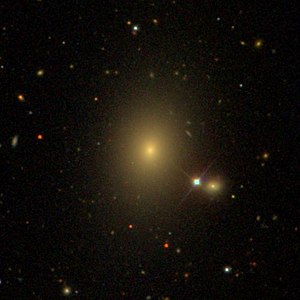NGC 5223
| Galaxy NGC 5223 |
|
|---|---|

|
|
| SDSS recording | |
| AladinLite | |
| Constellation | Hunting dogs |
|
Position equinox : J2000.0 , epoch : J2000.0 |
|
| Right ascension | 13 h 34 m 25.2 s |
| declination | + 34 ° 41 ′ 26 ″ |
| Appearance | |
| Morphological type | E. |
| Brightness (visual) | 12.7 mag |
| Brightness (B-band) | 13.7 mag |
| Angular expansion | 1.5 ′ × 1.3 ′ |
| Position angle | 168 ° |
| Surface brightness | 13.5 mag / arcmin² |
| Physical data | |
| Redshift | 0.024033 +/- 0.000087 |
| Radial velocity | 7205 +/- 26 km / s |
|
Stroke distance v rad / H 0 |
(324 ± 23) x 10 6 ly (99.4 ± 7.0) Mpc |
| history | |
| discovery | Wilhelm Herschel |
| Discovery date | May 1, 1785 |
| Catalog names | |
| NGC 5223 • UGC 8553 • PGC 47822 • CGCG 073-039 • MCG + 06-30-040 • 2MASX J13342524 + 3441255 • GC 3598 • H III 407 • h 1640 • LDCE 0983 NED016 | |
NGC 5223 is a 12.7 likes bright elliptical galaxy from the Hubble type E in the constellation of hunting dogs . It is estimated to be 324 million light years from the Milky Way and about 145,000 light years in diameter.
The object was discovered on May 1, 1785 by Wilhelm Herschel with an 18.7-inch reflector telescope, which she labeled “Two. Both vF, vS. A star between them about half way ”. The other object mentioned is NGC 5228 .
